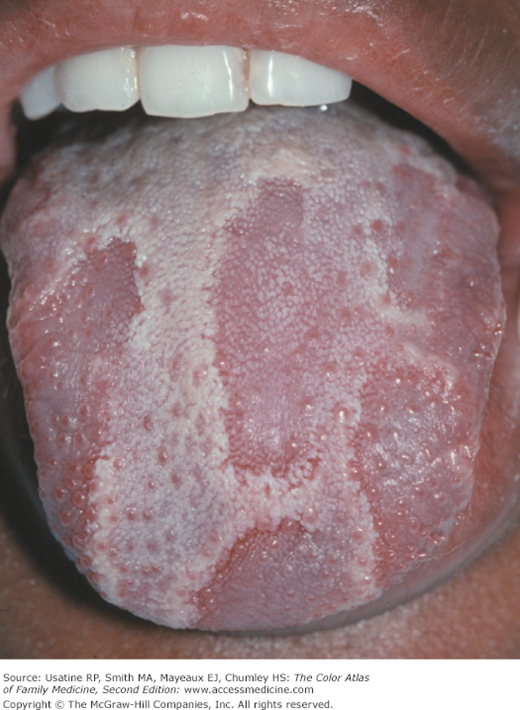Patient Story
A 23-year-old male medical student presents to the physician’s office complaining of his tongue’s “strange appearance.” He denies pain or discomfort and is unsure how long the lesions have been present. The lesions seem to change areas of distribution on the tongue. The examination reveals large, well-delineated, shiny and smooth, erythematous spots on the surface of the tongue (Figure 38-1). The diagnosis is geographic tongue (benign migratory glossitis). The physician explains that it is benign and that no treatment is needed unless symptoms develop.
Figure 38-1
Geographic tongue (benign migratory glossitis). Note the pink continents among the white oceans. (Reprinted with permission from Gonsalves WC, Chi AC, Neville BW. Common oral lesions: part II. Am Fam Phys 2007;75(4):501-508. Copyright © 2007 American Academy of Family Physicians. All rights reserved.)
Introduction
Geographic tongue is a recurrent, benign, usually asymptomatic, inflammatory disorder of the mucosa of the dorsum and lateral borders of the tongue. Geographic tongue is characterized by circinate, irregularly shaped erythematous patches bordered by a white keratotic band. The central erythematous patch represents loss of filiform papillae of tongue epithelium. Geographic tongue can, although rarely, present as symptomatic.
Epidemiology
Etiology and Pathophysiology
- Geographic tongue is a common oral inflammatory condition of unknown etiology.
- Some studies have shown an increased frequency in patients with allergies, pustular psoriasis, stress, type 1 diabetes, fissured tongue, and hormonal disturbances.3
- Histopathologic appearance resembles psoriasis.4
- Oddly, geographic tongue has an inverse association with cigarette smoking.2,5
Diagnosis
- The diagnosis is made by visual inspection and history of the lesion. The lesions are suggestive of a geographic map (hence geographic tongue) with pink continents surrounded by whiter oceans (Figure 38-1).
- Geographic tongue consists of large, well-delineated, shiny, and smooth, erythematous patches surrounded by a white halo (Figure 38-2).
- Tongue lesions exhibit central erythema because of atrophy of the filiform papillae and are usually surrounded by slightly elevated, curving, white-to-yellow elevated borders (Figures 38-1 and 38-2).
- The condition typically waxes and wanes over time so the lesions appear to be migrating (hence migratory glossitis).
- Lesions may last days, months, or years. The lesions do not scar.
- Most patients are asymptomatic, but some patients may complain of pain or burning, especially when eating spicy foods.
- Suspect systemic intraoral manifestations of psoriasis or reactive arthritis if the patient has psoriatic skin lesions or has conjunctivitis, urethritis, arthritis, and skin involvement suggestive of reactive arthritis (see Chapter 155, Reactive Arthritis).
- The lesions are typically found on the anterior two-thirds of the dorsal tongue mucosa.
- Geographic tongue usually affects the tongue, although other oral sites may be involved such as the buccal mucosa, the labial mucosa, and, less frequently, the soft palate.3
Stay updated, free articles. Join our Telegram channel

Full access? Get Clinical Tree




